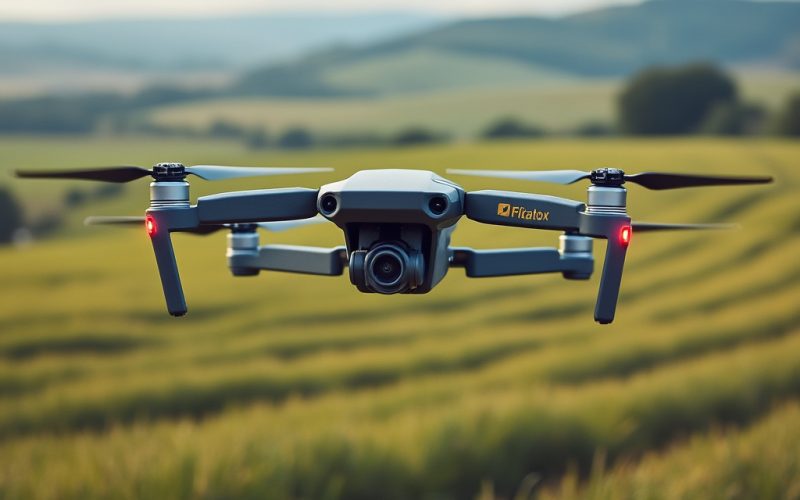
Drones are redefining sustainable agriculture, enabling farmers to reduce their environmental impact while boosting productivity. In Europe, they play a critical role in optimizing resources, monitoring crop health, and minimizing chemical use.
In this article we will show how they help agriculture become more sustainable, with real-life examples and an honest look at the challenges, including the investments to be done.
Application of Drone Technology in Agriculture
Drone technology is rapidly transforming agriculture, enabling farmers to work more precisely and sustainably than ever. From monitoring crop health to managing livestock and conserving resources, they provide critical data and actionable insights that enhance productivity while reducing environmental impact. We will show you various applications below with real-life examples.
Precision Agriculture: Reducing Resource Use with Targeted Interventions
Drones use multispectral and thermal cameras to collect detailed, real-time data on crop health, soil conditions, and pest infestations. This technology lets farmers apply water, fertilizer, and pesticides exactly where needed, cutting waste and preserving the environment.
Example: Swiss company Gamaya uses hyperspectral imaging to give farmers precise crop insights. By identifying exactly where to apply resources, Gamaya helps farmers reduce pesticide and fertilizer use, saving money and protecting surrounding ecosystems.
Sustainability Impact: Precision agriculture conserves water, limits chemical use, and keeps soil healthy—all essential for sustainable farming.
Early Detection of Crop Health Issues
Drones with infrared and thermal sensors spot early signs of stress, disease, or nutrient deficiencies, allowing farmers to act quickly and reduce chemical interventions. By tackling these issues early, farmers can avoid large-scale pesticide use and support healthier crops.
Example: The ICAERUS project in Europe demonstrates how they detect crop issues early. This proactive approach lets farmers apply fewer chemicals, reducing their environmental impact.
Sustainability Impact: Early problem detection keeps chemical use low, preserving biodiversity around farmland and promoting resilient, healthy crops.
Livestock Management: Protecting Land from Overgrazing
In livestock farming, drones monitor animals across vast grazing areas, preventing overgrazing, which can lead to soil degradation. By tracking animal health and movement, they help farmers manage livestock sustainably and avoid damaging the land.
Example: ICAERUS also showcases how drones improve livestock management by tracking animals over large areas. Farmers can optimize pasture use while protecting the environment.
Sustainability Impact: Drones help prevent overgrazing, preserving soil structure and promoting biodiversity, which supports long-term agricultural health.
Preserving Soil Quality by Reducing Machinery Use
Heavy machinery compacts soil, reducing its water absorption and nutrient availability. Drones allow farmers to monitor crops without stepping onto the field, preventing soil compaction and erosion.
Example: In the CHAMELEON project, drones monitor soil health from the air, reducing the need for machinery and keeping soil in its natural state.
Sustainability Impact: Healthy soil retains water better, cycles nutrients more effectively, and withstands drought—crucial for sustainable farming.
Lowering Agriculture’s Carbon Footprint
By replacing fuel-powered machinery, drones reduce emissions in agriculture. Handling tasks like spraying, monitoring, and surveying from the air minimizes fuel use, lowering greenhouse gas emissions.
Example: European farms now use drones to spray crops, reducing the need for tractors and minimizing emissions, fuel consumption, and soil disturbance.
Sustainability Impact: Fewer tractor trips cut emissions, directly supporting climate goals and promoting eco-friendly farming.
Case Studies: Drone Applications in European Agriculture
Several European initiatives showcase how drones make agriculture more sustainable. These examples reveal the real-world benefits they offer in farming:
- ICAERUS Project: ICAERUS focuses on precision crop monitoring and livestock management, showcasing how drones reduce resource use and chemical application.
- CHAMELEON Project: CHAMELEON uses drones to monitor soil health and assess biodiversity, promoting non-invasive methods of land and crop monitoring.
- Gamaya in Switzerland: By providing farmers with hyperspectral crop data, Gamaya helps them optimize their practices, boosting yields while minimizing environmental impact.
Challenges and Costs of Drone Adoption in Agriculture
Despite their benefits, they still present some barriers for farmers:
- High Initial Investment: Entry-level agricultural drones start at €1,000, while advanced models exceed €50,000. Essential sensors, like multispectral cameras, cost between €3,000 and €10,000, adding to the expense.
- Software and Data Processing: Data-processing software requires a significant investment, with annual subscriptions from €1,000 to €5,000. This software transforms raw data into actionable insights, but the cost may be challenging for smaller farms.
- Training and Certification: Operating drones requires specific skills and certifications. Training costs between €500 and €2,000, and EU regulations mandate licensing and insurance, adding to farmers’ expenses.
- Weather and Battery Limitations: Drones have limited battery life, and bad weather can ground them, affecting reliability. Farmers must plan around these constraints to avoid disruptions.
- Regulatory Compliance and Insurance: European Union regulations require permits and insurance for drone operations, with annual insurance premiums ranging from €500 to €2,000. Obtaining operational permits and adhering to strict safety guidelines can be time-consuming and costly.
Future Potential of Drones in Sustainable Agriculture
While cost and regulation challenges persist, advances in drone technology continue to improve accessibility. New developments in battery life, weather resistance, and data processing will make them even more practical and affordable for farmers.
Projects like ICAERUS, CHAMELEON, and Gamaya show drones’ transformative role in sustainable agriculture. As technology advances, they could become indispensable in farming, helping farmers increase yields, conserve resources, and protect the environment.
Drones empower sustainable agriculture by improving efficiency, reducing resource waste, and minimizing environmental impact. They thus support farmers in producing more with less, paving the way for a sustainable future in agriculture.
